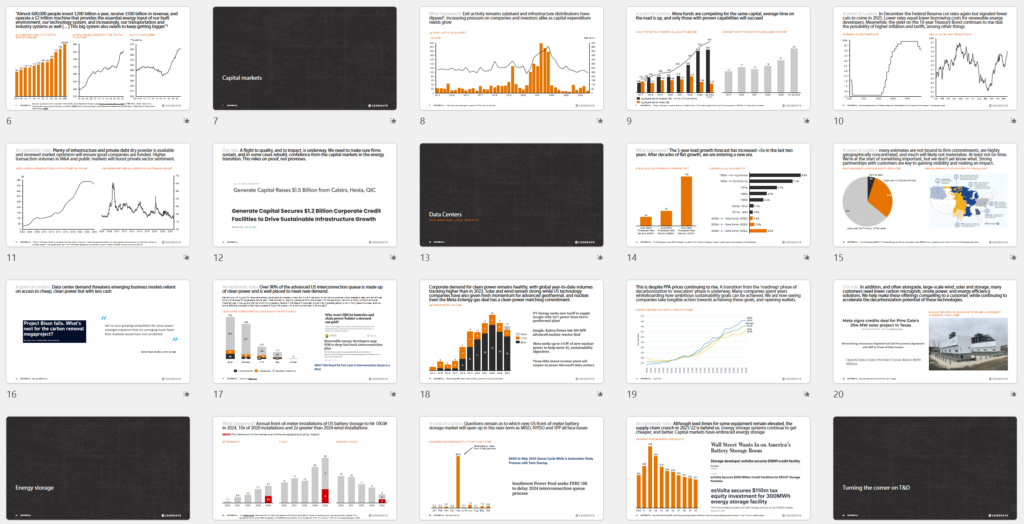DOWNLOAD
Submit the form below to continue your download
SUCCESS
Your download will begin shortly, if it does not start automatically, click the button below to download now.
DownloadBIO
Logan Goldie-Scot is a VP of Research and Impact at Generate Capital, responsible for building and communicating the firm’s information advantage. He is focused on developing proprietary insights relating to Generate’s six core sectors, while supporting market-wide coverage and origination efforts.
Prior to Generate, Logan joined BloombergNEF in 2010 and was Head of Clean Power research when he left in 2022. This was a 30-person group spanning solar, wind, energy storage and power grids. At BloombergNEF he previously worked as a solar analyst, built and led the Energy Storage team, and developed the firm’s first clean energy Index and ETF, in collaboration with Goldman Sachs. Logan is a regular writer, speaker and conference panellist on topics relating to the energy transition. He has an MA (Hons) in Arabic from Edinburgh University and in 2019 completed executive training in Supply Chain Management at Stanford GSB.
Where are we in the energy transition?
As we head into a new year, our colleagues across Generate reflected on the state of the projects and businesses we invest in and the impact of real and perceived headwinds on our sector’s ability to thrive. This comes as the transition to a sustainable economy meets the transition from a period of financial exuberance to a period of fiscal realism. What follows is the collective insight of our team. View the full presentation here.
Uncategorized By Logan Goldie-Scot
BIO
Logan Goldie-Scot is a VP of Research and Impact at Generate Capital, responsible for building and communicating the firm’s information advantage. He is focused on developing proprietary insights relating to Generate’s six core sectors, while supporting market-wide coverage and origination efforts.
Prior to Generate, Logan joined BloombergNEF in 2010 and was Head of Clean Power research when he left in 2022. This was a 30-person group spanning solar, wind, energy storage and power grids. At BloombergNEF he previously worked as a solar analyst, built and led the Energy Storage team, and developed the firm’s first clean energy Index and ETF, in collaboration with Goldman Sachs. Logan is a regular writer, speaker and conference panellist on topics relating to the energy transition. He has an MA (Hons) in Arabic from Edinburgh University and in 2019 completed executive training in Supply Chain Management at Stanford GSB.

The years of irrational exuberance are over but instead of despairing, we should be thankful for them. It allowed us to invent things we needed, to invest in things that wouldn’t have drawn investment, and to pass policies that have moved us forward materially. Much of what was invested in will survive in a more rigorous structure and will fit into the investable, bankable economy that we’re helping to build. Some of it will not. In the midst of CleanTech 1.0 in 2005, $51 billion was invested globally in the energy transition. Since 2021, global energy transition investment has been counted not in billions, but in trillions. The market has progressed massively, but this means that bankruptcies and failures will also be bigger.
The climate world oscillates between unhelpful optimism and unrealistic pessimism that forces it into corners that are unproductive, unrealistic, and uninvestable. Exuberance and despair may define the edges, but most good business and investing takes place in a stable core. The policy signals are dependable as we laid out in our August Generate: Intelligence Expert View, the capital markets are cautious but supportive, and good businesses continue to succeed. We are moving through a moment that all industries move through where the end of exuberance is the beginning of identifying the survivors. Those with good fundamentals will win and those who understand the opportunities will win.
The elephant in the room
This year, the world questioned the durability of the policy landscape which has enabled major investments in sustainable infrastructure. The US election was historically fractious, and cracks emerged in political coalitions across Europe.
Can the market-shaping frameworks developed through local, national, and multilateral processes during the giddy years of 2020-2023 withstand criticism that they were inflationary, restricted resources, and harmed local economies? In short, yes. The death of green policies has been exaggerated as the flows of capital into real projects and local economies to support these industries has made them locally popular even while they seem nationally vulnerable.
To be sure, the transforming landscape will mean changes to investment activities as new and emerging governing powers seek to put their mark on the transition. In the US, where the incoming Trump administration has been rhetorically hostile to the energy transition, some of the incentives will go away but most are likely to endure, even if their contours will look different. It is a reminder that the infrastructure transition does not represent a single asset class that is easily defined, but a broad physical economy that has attracted trillions in investment.
As we mentioned in our Expert View after the election, sustainable infrastructure capital flows protect policy structures by investing in the things that work for communities, answer customer demands, and make sense economically. That won’t change. While there will be movement on the margins, the core set of incentives that the infrastructure transition has relied on remains intact and politically durable across jurisdictions.
A deregulatory push more broadly could also unlock banks’ lending capacity, benefitting capital intensive areas such as sustainable infrastructure. Uncertainty around Basel III Endgame requirements have for instance lingered over the US tax equity market since the implementation proposals came out in July 2023. These efforts now appear dead.
The highlights
To make sense of this point in the transition, we highlight some optimistic signals and reasons to be cautious as you prepare for 2025. They build on our capital formation, operations, and investment expertise derived from a decade of successfully investing in the energy transition across North America and Europe.
The opportunity: We need to rebuild the physical economy of the United States. A failure to account for the overwhelming technological progress and clear global regulatory direction during this rebuild threatens the nation’s economic and geopolitical leadership.
Capital markets: Exit activity and distributions are subdued, leading to more competition for capital. The age of free money is over, prompting a flight to quality.
A new era of load growth: After decades of flat growth, we are entering a new era. The five-year load growth forecast has increased about 5x in the last two years. It is simultaneously a boon for clean power and could, if managed poorly, imperil several emerging technologies while locking in large-scale natural gas for decades.
A bumper year for storage: Annual front-of-meter installations of US battery storage are expected to hit 10GW in 2024, 10x more than 2020 installations.
Turning the corner on T&D: Transmission expansion and IQ reform is underway. Some processes will be slow, others quick. DG can play a key role, today.
Troubled supply chains, new opportunities: The US has rediscovered its manufacturing mojo, which is both an investment opportunity and a way to manage tariff and broader geopolitical uncertainty. Technology improvements and cost reductions remain a global story, keeping imports an option.
Green shoots for RNG: The outlook for Renewable Natural Gas from food or dairy waste is looking brighter, helping utilities and corporations decarbonize.
Mobility: Electric buses from our clean bus JV are already en route to school districts, and the outlook for passenger EVs is rosier than many believe.
Read through the full presentation.

More insights
Where are we in the energy transition?
The years of irrational exuberance are over but instead of despairing, we should be thankful for them. It allowed us to invent things we needed, to invest in things that wouldn’t have drawn investment, and to pass policies that have moved us forward materially. Much of what was invested in will survive in a more
Read moreIndustrial Decarbonization: How Thermal Storage Can Electrify Heat at Scale
Investment in thermal energy storage has accelerated in recent years as technical progress and customer demand have improved project bankability. Since 2020, sector funding has grown and shifted toward later-stage investors, reflecting greater confidence in TES’s readiness for commercial deployment.
Read moreConsolidation: The Pathway to Enduring Impact
It is easy to be disoriented by the swing from exuberance to pessimism that has defined the clean energy sector in recent years. Yet these moments are precisely when opportunity is greatest. Beneath the headlines are clear indicators of tremendous potential in the U.S. energy transition. The challenge is to separate fundamentals from sentiment, to acknowledge and fix the mistakes that we have made, and to chart a path to scale rooted in discipline, operational excellence, and commercial reality.
Read more
